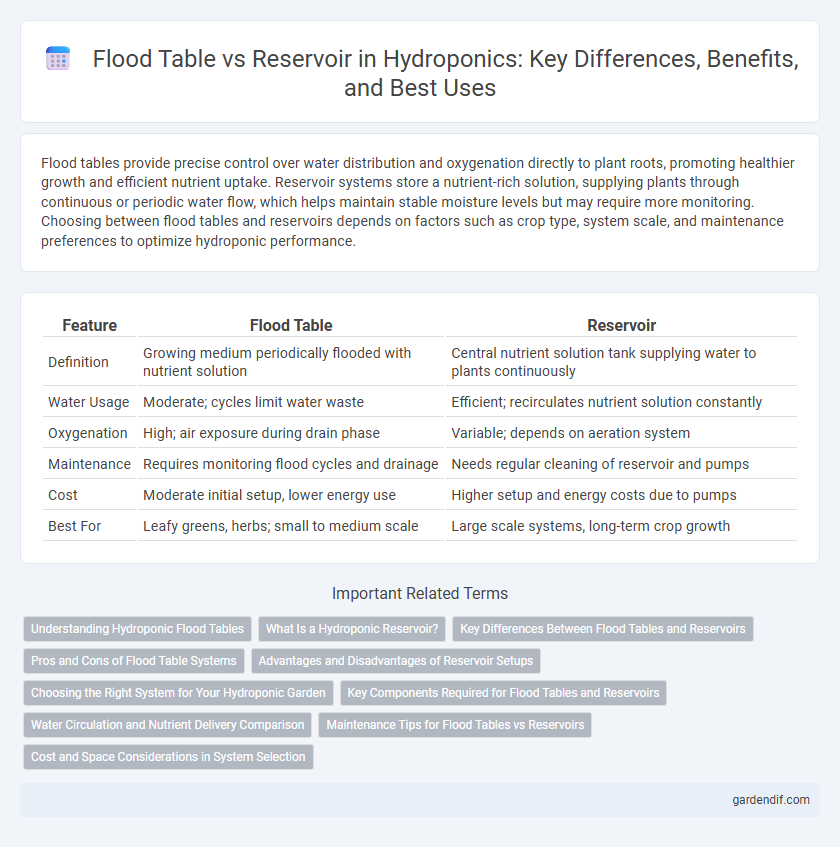
Flood Table vs Reservoir Illustration
Flood tables provide precise control over water distribution and oxygenation directly to plant roots, promoting healthier growth and efficient nutrient uptake. Reservoir systems store a nutrient-rich solution, supplying plants through continuous or periodic water flow, which helps maintain stable moisture levels but may require more monitoring. Choosing between flood tables and reservoirs depends on factors such as crop type, system scale, and maintenance preferences to optimize hydroponic performance.
Table of Comparison
| Feature | Flood Table | Reservoir |
|---|---|---|
| Definition | Growing medium periodically flooded with nutrient solution | Central nutrient solution tank supplying water to plants continuously |
| Water Usage | Moderate; cycles limit water waste | Efficient; recirculates nutrient solution constantly |
| Oxygenation | High; air exposure during drain phase | Variable; depends on aeration system |
| Maintenance | Requires monitoring flood cycles and drainage | Needs regular cleaning of reservoir and pumps |
| Cost | Moderate initial setup, lower energy use | Higher setup and energy costs due to pumps |
| Best For | Leafy greens, herbs; small to medium scale | Large scale systems, long-term crop growth |
Understanding Hydroponic Flood Tables
Hydroponic flood tables offer precise control over nutrient delivery by periodically flooding and draining the root zone, promoting optimal oxygenation and nutrient absorption for plants. Flood tables use a shallow tray filled with growing medium, allowing roots direct exposure to nutrient solutions during flood cycles, unlike reservoirs that hold static nutrient water for passive absorption. Understanding flood table systems helps growers enhance growth rates, reduce water waste, and improve overall crop yield in hydroponic setups.
What Is a Hydroponic Reservoir?
A hydroponic reservoir is a container that holds nutrient-rich water, supplying essential minerals directly to plant roots in a soilless system. Unlike flood tables, which regularly flood and drain the growing area, reservoirs maintain a consistent water level, ensuring steady nutrient availability and oxygenation through aeration systems. Proper reservoir management is crucial for preventing nutrient imbalances and promoting optimal plant growth in hydroponic setups.
Key Differences Between Flood Tables and Reservoirs
Flood tables provide a controlled, shallow water layer allowing roots to intermittently access nutrients and oxygen, optimizing plant growth through precise water level regulation. Reservoirs store larger volumes of nutrient-rich water, supplying continuous flow to hydroponic systems but requiring more maintenance to prevent stagnation and nutrient depletion. The key difference lies in water management: flood tables emphasize cyclical flooding for aeration, while reservoirs prioritize constant nutrient availability.
Pros and Cons of Flood Table Systems
Flood table systems in hydroponics offer precise control over water and nutrient delivery, enhancing plant growth efficiency and reducing water waste. These systems facilitate easy access for maintenance and monitoring, leading to improved crop yields, but they require careful management to prevent root diseases from standing water. Compared to reservoir systems, flood tables can be more expensive to set up and maintain, with higher energy consumption due to frequent water cycling.
Advantages and Disadvantages of Reservoir Setups
Reservoir setups in hydroponic systems offer precise water and nutrient control, reducing waste and facilitating easier pH and EC management. However, they can be prone to issues like root diseases from stagnant water if not properly aerated, and they require regular monitoring to prevent nutrient imbalances. Compared to flood tables, reservoirs typically demand more maintenance but provide greater consistency in nutrient delivery for steady plant growth.
Choosing the Right System for Your Hydroponic Garden
Choosing between flood table and reservoir systems depends on your garden size, plant variety, and maintenance preferences. Flood tables offer precise water and nutrient control, ideal for larger setups with diverse crops, while reservoir systems suit smaller gardens, providing a simpler, low-maintenance solution. Evaluating factors like water circulation, oxygenation, and growth rates ensures optimal performance for your hydroponic garden's specific needs.
Key Components Required for Flood Tables and Reservoirs
Key components required for flood tables in hydroponic systems include a sturdy growing tray, a submersible pump to control water flow, an overflow drain to prevent flooding, and a timer for precise irrigation scheduling. Reservoirs necessitate a water container for nutrient solution storage, an aeration system to maintain oxygen levels, and plumbing connections to circulate the solution. Both systems rely on precise water management components to optimize nutrient delivery and promote healthy plant growth.
Water Circulation and Nutrient Delivery Comparison
Flood tables provide direct water circulation by intermittently flooding plant roots, promoting oxygen availability and efficient nutrient absorption. Reservoir systems maintain a constant nutrient solution, ensuring steady nutrient delivery but potentially reducing oxygen levels around roots. Flood tables typically enhance root aeration and nutrient uptake compared to the static environment of reservoirs, making them suitable for plants requiring higher oxygenation.
Maintenance Tips for Flood Tables vs Reservoirs
Regularly inspect flood tables for clogged drain holes and clean pump filters to ensure efficient water circulation, preventing algae buildup and root rot. Reservoirs require monitoring water levels and temperature, along with periodic cleaning to avoid nutrient solution contamination and microbial growth. Both systems benefit from routine sanitation, pH level checks, and timely replacement of worn components to maintain optimal hydroponic conditions.
Cost and Space Considerations in System Selection
Flood table hydroponic systems typically require more initial investment due to the complex structure and water management components, while reservoir systems offer cost efficiency with simpler designs and fewer parts. Space considerations favor reservoir systems, as they can be compact and stacked vertically, optimizing limited indoor or greenhouse areas. Selecting between flood tables and reservoirs depends on balancing budget constraints with available space and desired crop yield density.
Flood Table vs Reservoir Infographic

 gardendif.com
gardendif.com